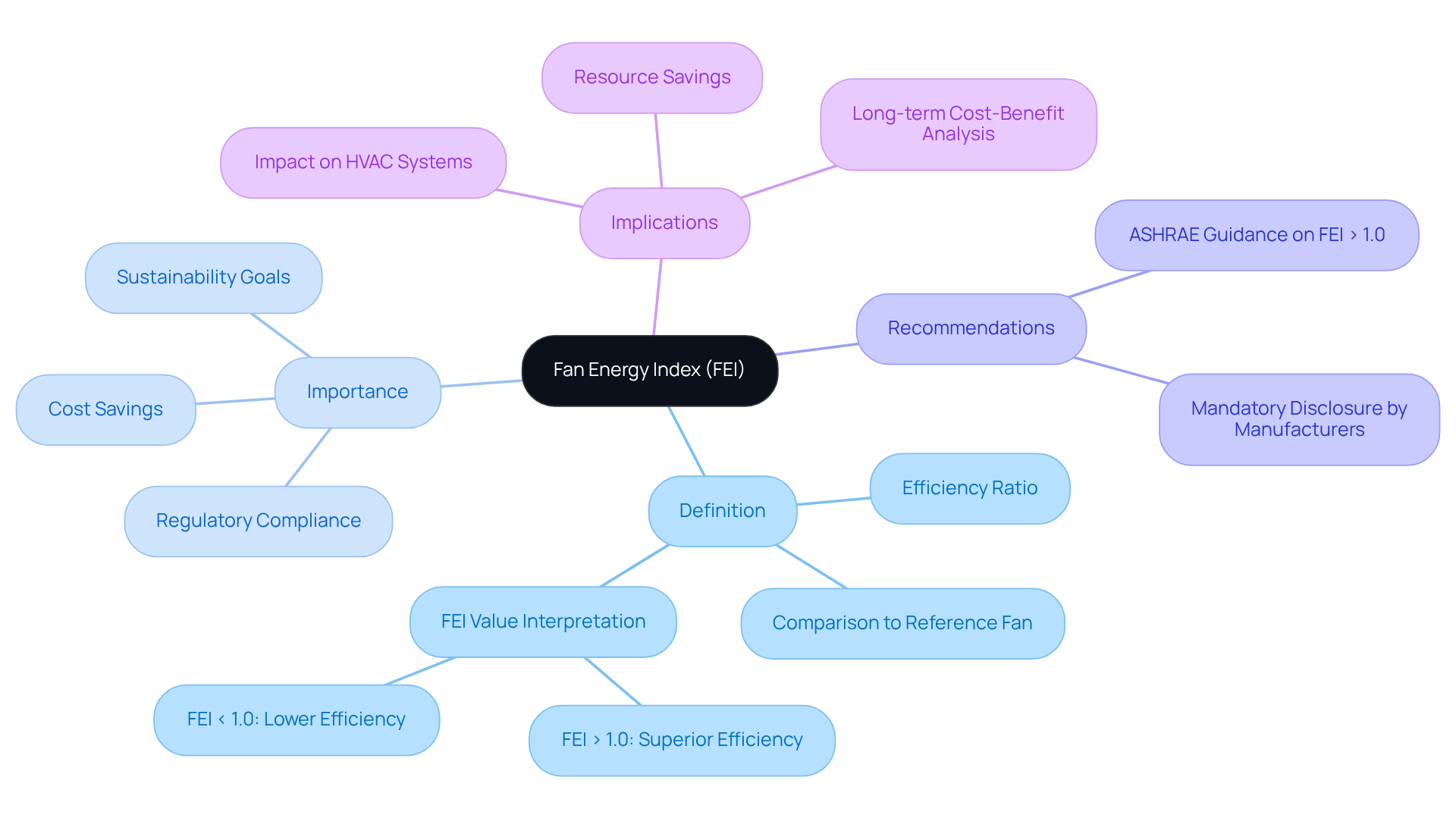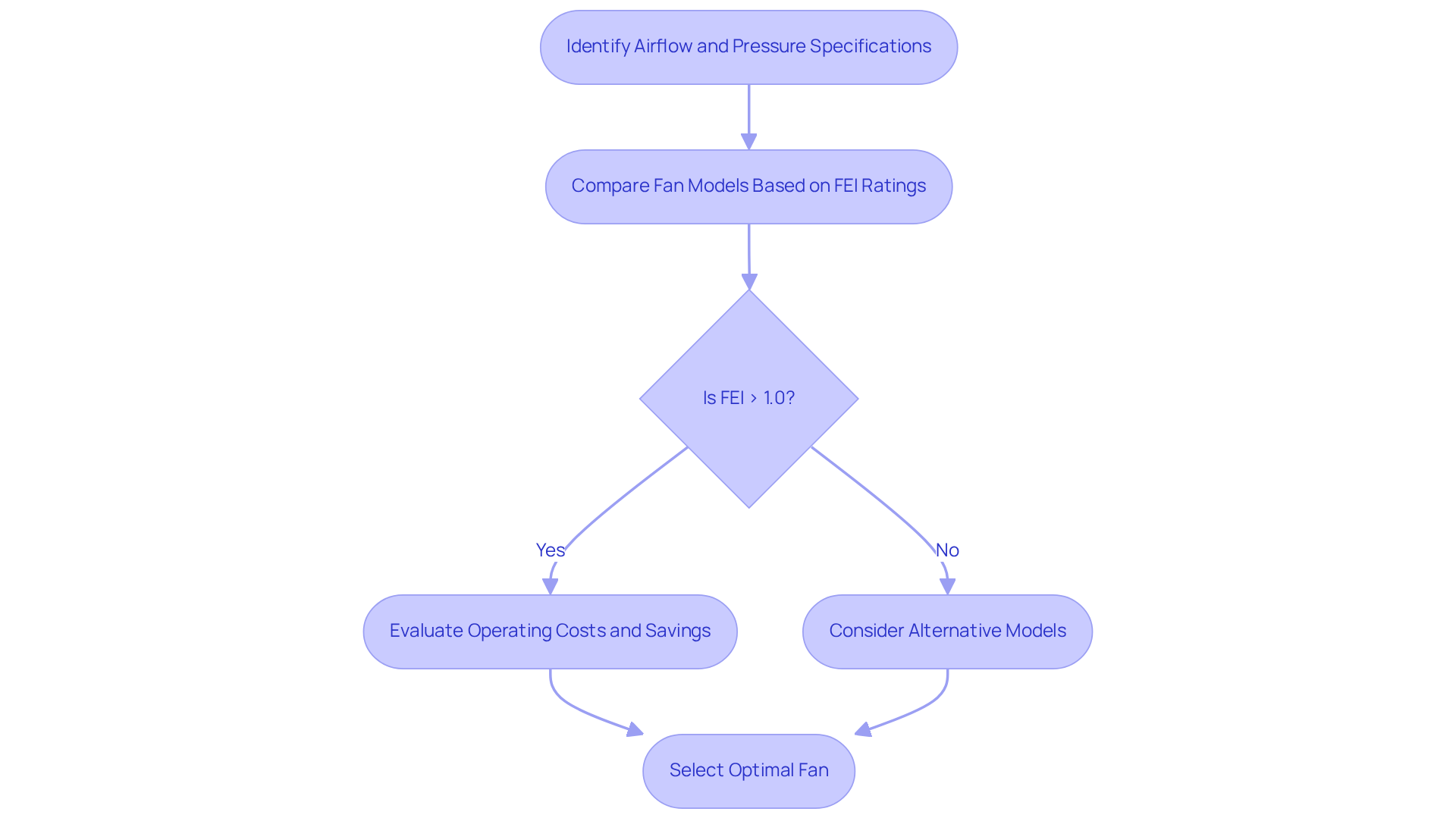Introduction
Understanding the Fan Efficiency Index (FEI) is crucial for professionals engaged in energy-efficient design, especially within the HVAC sector. This innovative metric not only quantifies the efficiency of fan systems but also acts as a vital tool for adhering to evolving energy regulations and sustainability objectives. As engineers work to optimize performance while minimizing costs, they face the challenge of navigating the complexities of fan selection. In this landscape, even a slight increase in efficiency can lead to substantial savings.
So, how can professionals effectively leverage the FEI to make informed decisions that enhance both operational efficiency and environmental responsibility? By understanding the intricacies of the FEI, engineers can better align their strategies with industry standards and sustainability goals, ultimately driving both performance and compliance.
Define the Fan Energy Index (FEI) and Its Importance
The fan efficiency index (FEI) is a crucial measure established by AMCA International, aimed at evaluating the efficiency of fan systems. It quantifies the ratio of a fan’s actual electrical input power to that of a reference fan operating under identical airflow and pressure conditions. An FEI value exceeding 1.0 signifies superior efficiency compared to the reference fan, while a value below 1.0 indicates lower efficiency. The fan efficiency index is essential for compliance with codes and regulations, as it encourages the selection of devices that reduce power consumption and operational costs.
ASHRAE recommends opting for fans with an FEI value greater than 1.0, as these fans exceed industry benchmarks, delivering enhanced savings and performance. For instance, a fan system with an FEI of 1.10 will consume 10% less power than a baseline fan rated at 1.00. Starting October 31, 2023, manufacturers will be mandated to disclose their FEI ratings in their materials, underscoring the significance of this metric within the industry.
By understanding the fan efficiency index, engineers can make informed decisions that support sustainability objectives and regulatory compliance, leading to substantial resource savings in HVAC systems and beyond. The introduction of the fan efficiency index (FEI) has revolutionized the evaluation of fan efficiency, moving beyond traditional metrics and aligning with modern power standards.

Apply FEI in Selecting Energy-Efficient Fans
When selecting energy-efficient devices, engineers must first identify the required airflow and pressure specifications for their specific applications. With these parameters established, they can effectively compare various fan models based on their fan efficiency index ratings. An FEI value exceeding 1.0 signifies that the fan operates more efficiently than the theoretical reference fan, which has a fan efficiency index of 1.0. This elevated fan efficiency index value is correlated with reduced power consumption and lower operational costs.
For example, consider two units that meet identical performance standards: one with an FEI of 1.2 and the other with an FEI of 0.9. The unit with a higher fan efficiency index will incur significantly lower operating costs over its lifespan. Gagner-Toomey Associates offers a comprehensive range of DC input Tube Axial units, available in sizes from 15 to 280mm, alongside Centrifugal Blowers ranging from 15 to 225mm. These products are optimized for performance and efficiency, making them ideal choices for engineers who prioritize fan efficiency index in their designs.
Moreover, engineers should evaluate the benefits of variable speed drives, which adjust fan speed according to demand, leading to additional savings. By focusing on fans with a fan efficiency index above 1.0, designers not only comply with the latest power regulations, including the ASHRAE 90.1-2022 standards, but also contribute to broader sustainability initiatives. This approach ultimately results in more cost-effective and eco-friendly solutions. Gagner-Toomey’s innovative cooling solutions, including their extensive range of thermal management products, further empower engineers to achieve optimal performance in their applications.

Explore the Benefits of FEI-Rated Systems
FEI-rated systems present numerous advantages that extend well beyond mere compliance with the fan efficiency index and efficiency codes. They primarily facilitate significant reductions in energy consumption, resulting in lower utility bills and operational costs. For instance, facilities that transition to FEI-rated motors can achieve average savings of 600 kWh/hp in industrial applications and 375 kWh/hp in commercial settings, translating to annual savings that can exceed $1,000 for a 20 horsepower unit.
Moreover, these systems play a crucial role in minimizing carbon footprints, aligning with global sustainability objectives and corporate accountability initiatives. Notably, 18% of emissions from buildings stem from indirect emissions generated by the electricity and heat consumed by these structures.
In addition to energy savings, FEI-rated fans are recognized for their quieter operation and enhanced reliability, which contribute to reduced maintenance costs and extended equipment lifespans. By investing in systems with a fan efficiency index (FEI) rating, organizations not only comply with regulatory standards but also position themselves as leaders in energy efficiency and sustainability efforts.
As highlighted by the Air Movement and Control Association, the fan efficiency index (FEI) helps design professionals in selecting the most energy-efficient fan to meet the required pressure and flow for each building.

Conclusion
Understanding the fan efficiency index (FEI) is crucial for engineers and designers focused on optimizing energy efficiency in their projects. This metric serves as a benchmark for fan performance and encourages the selection of systems that minimize energy consumption and operational costs. By prioritizing fans with an FEI greater than 1.0, professionals can ensure compliance with industry standards while contributing to sustainability efforts.
The significance of the FEI in selecting energy-efficient fans cannot be overstated. Higher FEI values correlate directly with reduced power usage, making it an essential consideration for engineers. By leveraging this index, they can make informed choices that align with both performance requirements and sustainability goals. Moreover, adopting FEI-rated systems offers benefits beyond mere cost savings; these systems also promote quieter operations and extend equipment lifespans.
Ultimately, embracing the fan efficiency index transcends regulatory compliance; it represents a strategic initiative toward achieving energy efficiency and environmental responsibility. By prioritizing FEI in design and selection processes, organizations can lead the charge in sustainable practices while reaping the financial rewards of reduced energy consumption. The call to action is clear: prioritize FEI in fan selection to foster a more energy-efficient future.
Frequently Asked Questions
What is the Fan Efficiency Index (FEI)?
The Fan Efficiency Index (FEI) is a measure established by AMCA International to evaluate the efficiency of fan systems, quantifying the ratio of a fan’s actual electrical input power to that of a reference fan operating under the same airflow and pressure conditions.
How is the FEI value interpreted?
An FEI value exceeding 1.0 indicates superior efficiency compared to the reference fan, while a value below 1.0 indicates lower efficiency.
Why is the FEI important?
The FEI is important for compliance with codes and regulations, as it encourages the selection of fans that reduce power consumption and operational costs.
What does ASHRAE recommend regarding FEI values?
ASHRAE recommends opting for fans with an FEI value greater than 1.0, as these fans exceed industry benchmarks, providing enhanced savings and performance.
Can you provide an example of how FEI affects power consumption?
For instance, a fan system with an FEI of 1.10 will consume 10% less power than a baseline fan rated at 1.00.
What new requirement will take effect on October 31, 2023, regarding FEI?
Starting October 31, 2023, manufacturers will be required to disclose their FEI ratings in their materials, highlighting the significance of this metric in the industry.
How does understanding FEI benefit engineers?
By understanding the FEI, engineers can make informed decisions that support sustainability objectives and regulatory compliance, leading to substantial resource savings in HVAC systems and beyond.
How has the introduction of FEI changed the evaluation of fan efficiency?
The introduction of the FEI has revolutionized the evaluation of fan efficiency by moving beyond traditional metrics and aligning with modern power standards.

